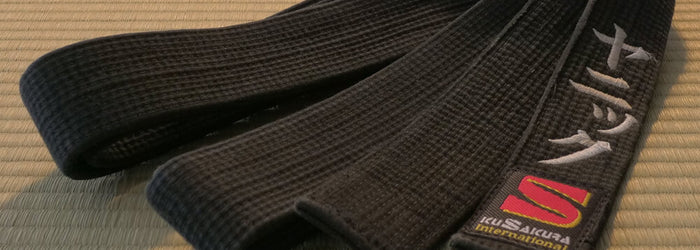KuSakuraShop will be closed from December 27th to January 4th. The shipping of your orders and customer support will be on hold during this period.
-
2025~2026 New Year's Holidays | -
Merge KuSakura International x France | -
New Products & Navigation Menu Rework | New Products Now Available Online & New Shopping Menu! -
Review Reward Campaign | Leave a comment on your recent purchase and receive a 5% discount.
How to take care of your Judo equipment
Washing instructions and all you need to know to take care of your equipment
Taking care of your equipment is of the utmost importance when practicing a traditional martial art.
It will allow you to make it last longer, and it will ensure better safety during training - especially for weapons.
Having a clean Judogi is also a matter of respect, for your partners, and for yourself.
Contents
How to Take care of your Judogi
On every Judogi (jacket and pants) you will find a tag with washing instructions written on it. Note that the Dogi will shrink about 6% over the first washings and will afterwards match the measurements indicated in the size table. Therefore, do not take the shrinkage into consideration when choosing your size.
Before first use, you can simply wash your Judogi in cold water. However, if you want to make it shrink to the maximum from the very begining, you can wash it 2 or 3 times in hot water, maximum 60°C.

A well used KuSakura Judogi
- Washing machine at 30° C maximum.
- Wash separately (note that the blue Dogi models bleeds).
- Do not use bleach or fabric softener.
- Do not tumble dry.
- Iron at medium heat.
- Our tip: wash your Dogi just after the class, with little or no detergent in cold water. Then every 3 or 4 classes (at least once a week), wash with detergent at 30° C.
Wash it immediately after practice and refrain from using too much detergent as this can damage the fabric when poorly rinsed. More washing powder does not clean your Judogi better, and if poorly rinsed, facilitates the development of mold. It is better to simply wash it twice instead. Once washed, put it on a hanger to keep its shape and avoid direct sunlight when letting it dry outside. And no, unfortunately there is no way to fix a Judogi that blackened on the inside of the sleeves or the collar.
If you feel your Judogi really needs a strong wash, you can try washing it with: reasonable quantity of detergent (too much won't help anyway) + temperature at 60°C + a cup of bleach. Before your washing machine start the rinsing process, stop the machine for one hour. Then finish the cycle. We do not recommend this method, but that's the one we use oursleves when it becomes absolute necessity.
How to wash your Judo Belt (Obi)
Have you ever been wondering if you should actually wash your belt or not? In Japan, nobody asks this, but in the West, it is quite common to be told that "traditionally, with washing your belt you would wash away your practice experience" or something like that. That is nonsense. Belts can and should be washed like all your training equipment, or at least once in a while. Respect the same washing indications as listed above for the Dogi. And note: Your belt may probably shrink up to 10 cm - but will stretch back into almost its original length when tying.

A well used KuSakura Belt
-
Washing machine at 30°C maximum.
Hand washing works as well! - Wash separately.
- Do not use bleach or fabric softener.
- Do not tumble dry.
- You can fold it and make a knot with the belt to avoid entangeling with other clothes.
- Iron at medium heat (to your liking)
- Beware, colored belts bleed, make sure not to wash your colored belt with your white Judogi.
Wooden Weapons
Although wooden weapons are generally less important in Judo than other martial arts, it is still important to properly take care of them to avoid any risk evolving around damaged weapons.
Make sure to store your weapons horizontally to keep them from bending!
Tip and bottom of vertically stored weapons are exposed to different temperature and humidity levels and bend easily. This can happen over a relatively short period of time, even to varnished weapons. Store them horizontally in a dry and cool place.
Varnished Weapons
Varnished weapons are more resistant and can be kept for many years without particular maintenance.
As in Judo they are not used for contact practice, the thin varnish layer will last and protect the weapons for many years.
In case you purchased your weapons at a very cheap price, they are likely from China or Taiwan and of rather poor quality. The thick coating might cover cracks and fissures - so be careful and regularly check your weapons before usage.
Unvarnished Weapons
Unvarnished weapons are polished with camellia oil several times before shipment. The oil nourishes the timber and helps prevent the weapons from warping.
And that is what you should do about once a month. Grab a piece of cloth and dip it in a wood maintenance product or vegetable oil and lubricate the unvarnished weapons. Let it dry and repeat the process 2 to 3 times until the wood does not absorb the oil any longer. The denser the wood, the less you oil you will need. If you use vegetable oil, you can put the oil directly on your hands. It makes things easier, and that kind of oil is actually good for the skin!
Your wooden weapons will become darker over the years and thanks to this process, the wood density will slightly increase.

All unvarnished weapons are oiled several times before shipping